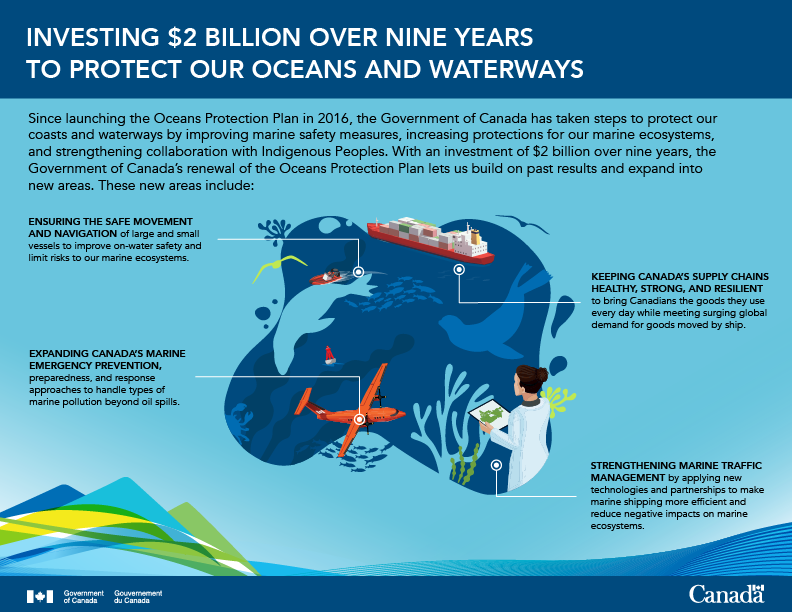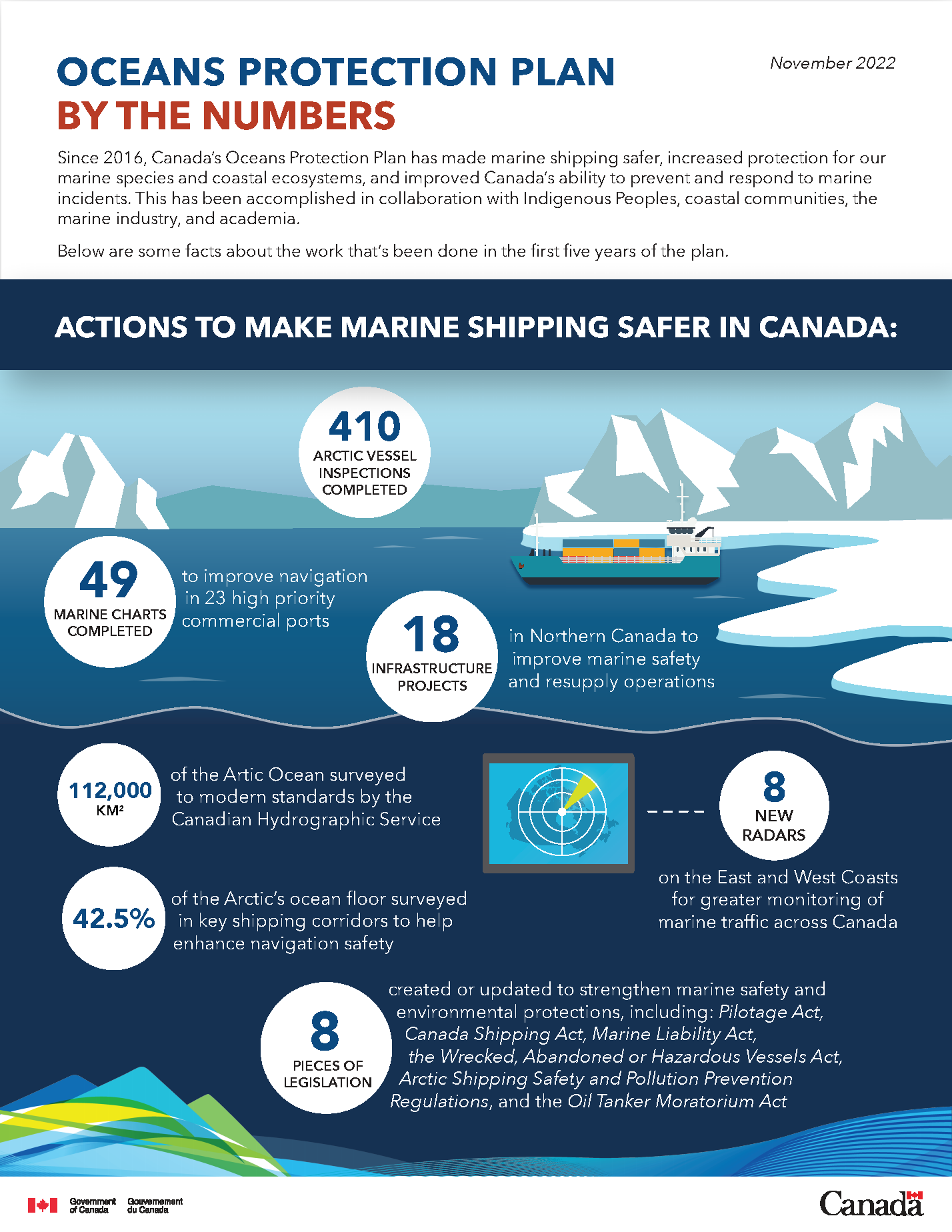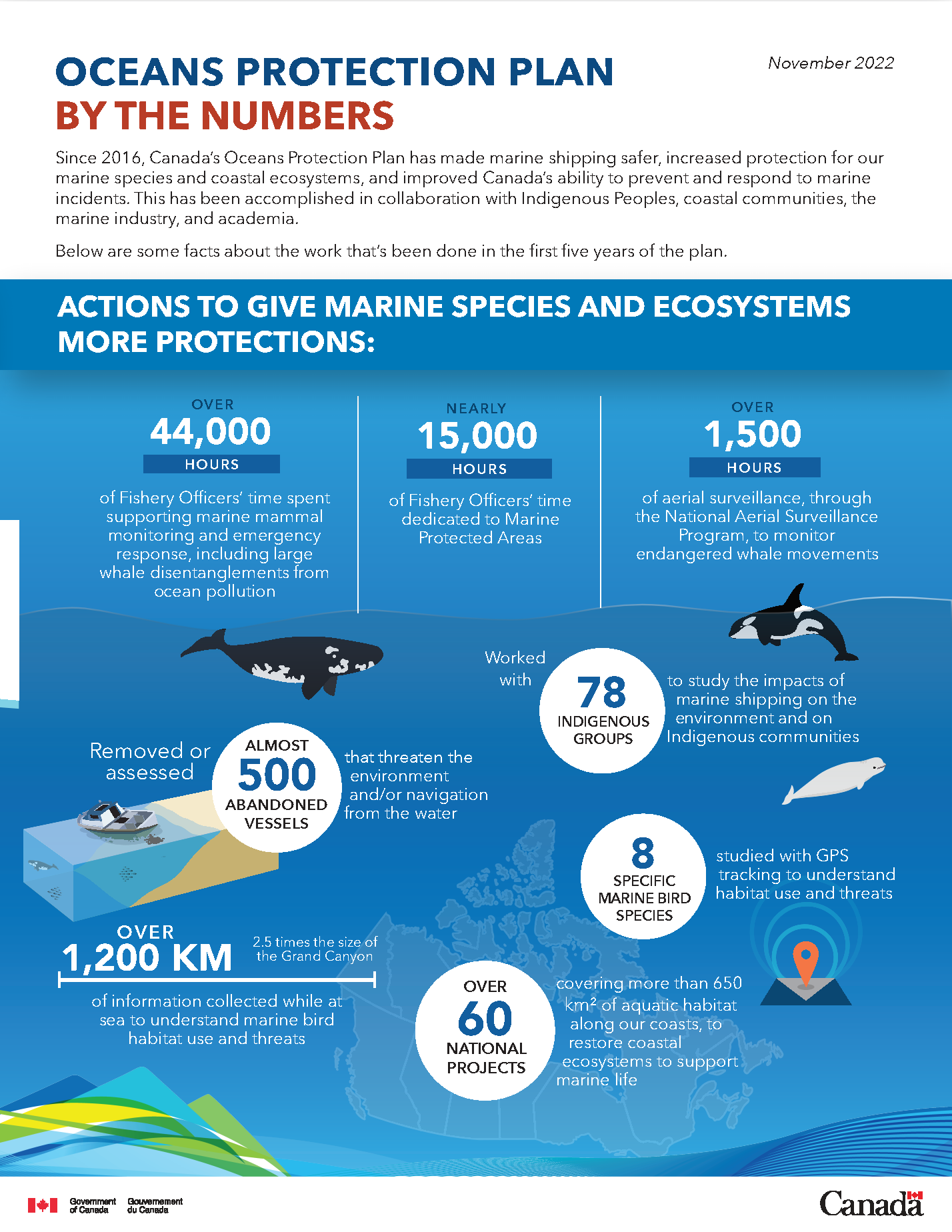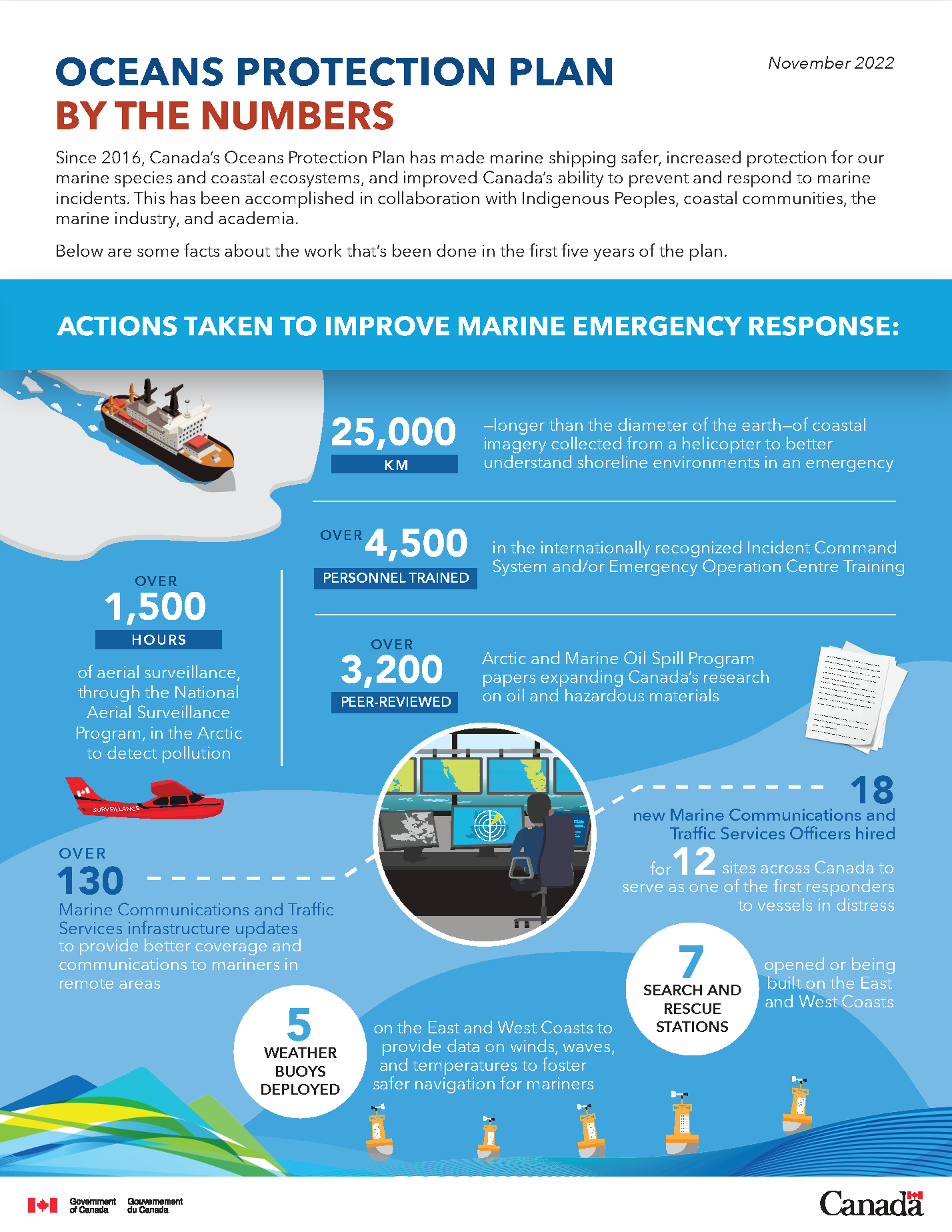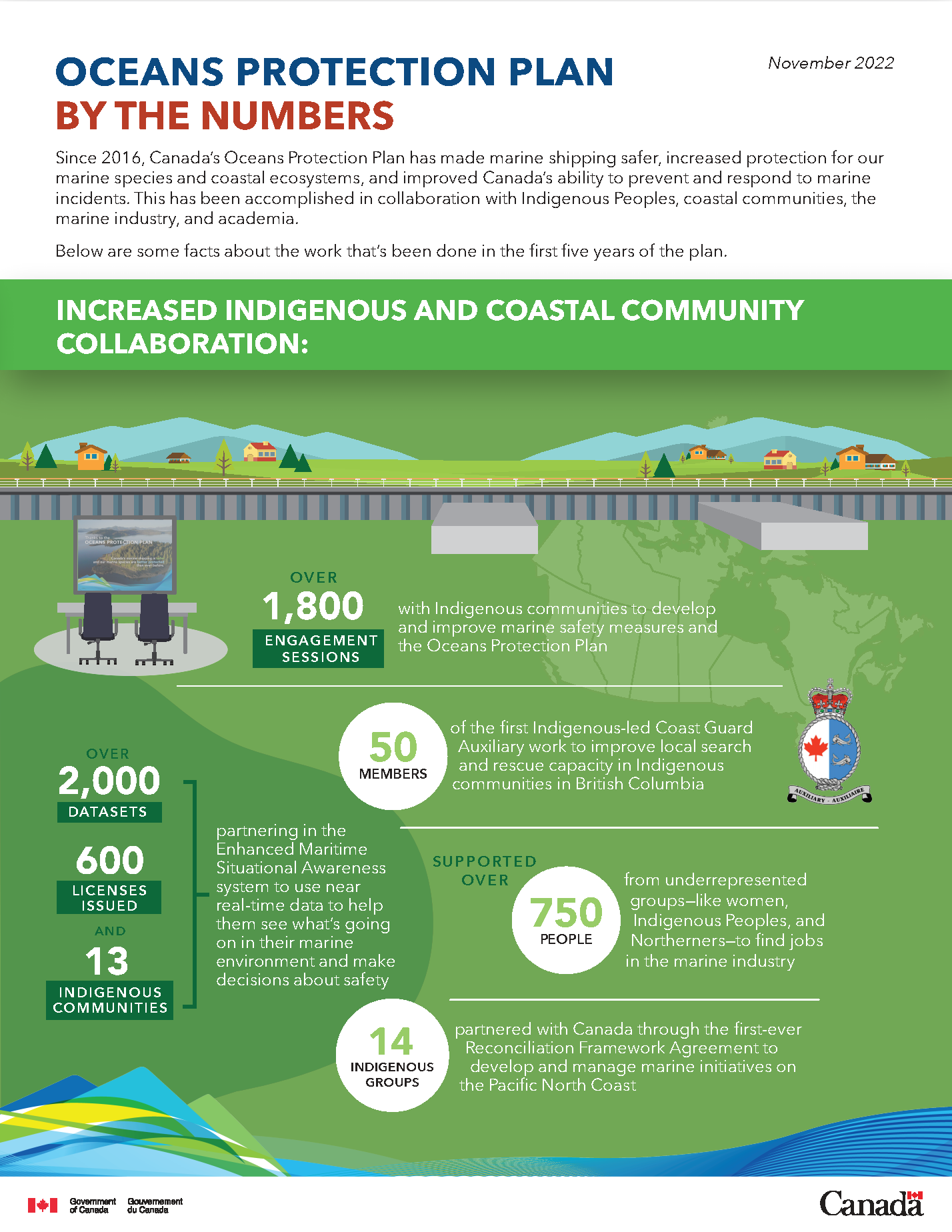The national Oceans Protection Plan is the largest investment ever made to protect Canada's coasts and waterways for future generations, while growing our economy.
Investing $2 billion over nine years to protect our oceans and waterways
Description: Investing $2 billion over nine years to protect our oceans and waterways
Since launching the Oceans Protection Plan in 2016, the Government of Canada has taken steps to protect our coasts and waterways by improving marine safety measures, increasing protections for our marine ecosystems, and strengthening collaboration with Indigenous Peoples. With an investment of $2 billion over nine years, the Government of Canada’s renewal of the Oceans Protection Plan lets us build on past results and expand into new areas. These new areas include:
- Ensuring the safe movement and navigation of large and small vessels to improve on-water safety and limit risks to our marine ecosystems.
- Expanding Canada’s marine emergency prevention, preparedness, and response approaches to handle types of marine pollution beyond oil spills.
- Keeping Canada’s supply chains healthy, strong, and resilient to bring Canadians the goods they use every day while meeting surging global demand for goods moved by ship.
- Strengthening marine traffic management by applying new technologies and partnerships to make marine shipping more efficient and reduce negative impacts on marine ecosystems.
Oceans Protection Plan by the Numbers
Description: Actions to make marine shipping safer in Canada
Since 2016, Canada’s Oceans Protection Plan has made marine shipping safer, increased protection for our marine species and coastal ecosystems, and improved Canada’s ability to prevent and respond to marine incidents. This has been accomplished in collaboration with Indigenous Peoples, coastal communities, the marine industry, and academia.
Below are some facts about the work that’s been done so far.
- 410 Arctic vessel inspections completed
- 49 marine charts completed to improve navigation in 23 high priority commercial ports
- 8 new radars on the East and West Coasts for greater monitoring of marine traffic across Canada
- 42.5% of the Arctic’s ocean floor surveyed in key shipping corridors to help enhance navigation safety
- 8 pieces of legislation created or updated to strengthen marine safety and environmental protections, including: Pilotage Act, Canada Shipping Act, Marine Liability Act, the Wrecked, Abandoned or Hazardous Vessels Act, Arctic Shipping Safety and Pollution Prevention Regulations, and the Oil Tanker Moratorium Act
- 18 infrastructure projects in Northern Canada to improve marine safety and resupply operations.
- 112,000 square kilometres of the Arctic Ocean surveyed to modern standards by the Canadian Hydrographic Service.
Description: Actions to give marine species and ecosystems more protections
Since 2016, Canada’s Oceans Protection Plan has made marine shipping safer, increased protection for our marine species and coastal ecosystems, and improved Canada’s ability to prevent and respond to marine incidents. This has been accomplished in collaboration with Indigenous Peoples, coastal communities, the marine industry, and academia.
Below are some facts about the work that’s been done so far.
- Over 44,000 hours Fishery Officers’ spent supporting marine mammal monitoring and emergency response, including large whale disentanglements from ocean pollution.
- Nearly 15,000 hours of Fishery Officers’ time dedicated to Marine Protected Areas.
- Over 1,500 hours of aerial surveillance, through the National Aerial Surveillance Program, to monitor endangered whale movements
- Removed or assessed over 500 abandoned vessels that threaten the environment and/or navigation from the water
- 8 specific marine bird species studied with GPS tracking to understand habitat use and threats
- Over 1,200 KM—2.5 times the size of the Grand Canyon—of at-sea marine bird information collected to understand habitat use and threats
- Over 60 national projects, covering more than 650 square kilometres of aquatic habitat along our coasts, to restore coastal ecosystems to support marine life Worked with 78 Indigenous groups to study the impacts of marine shipping on the environment and on Indigenous communities
Description: Actions taken to improve marine emergency response
Since 2016, Canada’s Oceans Protection Plan has made marine shipping safer, increased protection for our marine species and coastal ecosystems, and improved Canada’s ability to prevent and respond to marine incidents. This has been accomplished in collaboration with Indigenous Peoples, coastal communities, the marine industry, and academia.
Below are some facts about the work that’s been done so far.
- 25,000 KM—longer than the diameter of the earth—of coastal imagery collected from a helicopter to better understand shoreline environments in an emergency
- Over 4,500 personnel trained in the internationally recognized Incident Command System and/or Emergency Operation Centre Training
- Over 3,200 peer-reviewed Arctic and Marine Oil Spill Program papers expanding Canada’s research on oil and hazardous materials
- Over 1,500 hours of aerial surveillance, through the National Aerial Surveillance Program, in the Arctic to detect pollution
- Over 130 Marine Communications and Traffic Services infrastructure updates to provide better coverage and communications to mariners in remote areas
- 5 weather buoys deployed on the East and West Coasts to provide data on winds, waves, and temperatures to foster safer navigation for mariners
- 7 search and rescue stations opened or being built on the East and West Coasts
Description: Increased Indigenous and Coastal community collaboration
Since 2016, Canada’s Oceans Protection Plan has made marine shipping safer, increased protection for our marine species and coastal ecosystems, and improved Canada’s ability to prevent and respond to marine incidents. This has been accomplished in collaboration with Indigenous Peoples, coastal communities, the marine industry, and academia.
Below are some facts about the work that’s been done so far.
- Over 1,800 engagement sessions with Indigenous communities to develop and improve marine safety measures and the Oceans Protection Plan
- Over 2,000 datasets collected, 600 licenses issued, and 13 Indigenous communities partnering in the Enhanced Maritime Situational Awareness system to use near real-time data to help them see what’s going on in their marine environment and make decisions about safety
- 50 members of the first Indigenous-led Coast Guard Auxiliary work to improve local search and rescue capacity in Indigenous communities in British Columbia
- 14 Indigenous groups partnered with Canada through the first-ever Reconciliation Framework Agreement to develop and manage marine initiatives on the Pacific North Coast
- Supported over 750 people from underrepresented groups—like women, Indigenous Peoples, and Northerners—to find jobs in the marine industry
Ocean Protection Plan - Infographics
(PDF, 11.8 MB)
How Canada is investing in the Oceans Protection Plan
Description: How Canada is investing in the Oceans Protection Plan
Since 2016, Canada’s Oceans Protection Plan has made marine shipping safer, increased protection for our marine species and coastal ecosystems, and improved Canada’s ability to prevent and respond to marine incidents. This work has been accomplished through a variety of investments in science, equipment and people, and in collaboration with Indigenous Peoples, coastal communities, the marine industry, and academia. For more results on the Oceans Protection Plan, click here.
Here’s a snapshot of some of the investments made
Improving marine safety and emergency response
- Over $100 M to build six new search and rescue stations to increase marine incident response capacity on the east and west coasts
- Over $67 M to lease two emergency offshore towing vessels to tow large commercial ships in distress and prevent incidents
- Over $20 M to develop marine training programs and increase job opportunities for women, Northerners, Inuit, and Indigenous Peoples in the marine sector
Advancing research and science
- Over $45 M to expand research on alternative oil-spill response technology to limit potential harm to the environment
- Over $17 M for new weather modelling which improves oil-spill tracking and supports a more effective incident response
Building meaningful partnerships with Indigenous Peoples
- Over $62 M to create a web-based system that provides Indigenous and coastal communities with near real-time data to help them see what is going on in their marine environment for safety, decision-making, and planning
- Over $6.4 M to help Indigenous communities purchase search and rescue boats as well as supplies to enhance their role in the Canadian Coast Guard Auxiliary
- Over $64 M to improve and upgrade critical re-supply operations for food and goods to northern communities
Healthier coasts and protecting marine species
- Over $70 M to restore the health of over 60 aquatic habitats nationally
- Over $8 M to assess and remove over 300 hazardous abandoned boats across Canada which threaten navigation and the environment
*Investment dollars displayed reflect announced funding amounts current as of March 2021.
Pictured: Map of Canada; a coast guard vessel; two tugboats; two weather buoys; two Southern Resident killer whales; a school of fish; a search and rescue boat; hands holding a digital map displayed on a tablet; a bulk carrier ship; a seal with a school of fish, and an abandoned boat.
How Canada is investing in the Oceans Protection Plan
(PDF, 597 KB)
Oceans Protection Plan - Funding graphic
Description: Oceans Protection Plan - Funding graphic
$1.5 Billion
$278 Million - Improved emergency preparedness and response
- Establishing 24/7 emergency response and incident management
- Increasing on-scene environmental response capacity
- Improving oil spill response plans
$250 Million - Increased Canadian Coast Guard capacity for prevention and response
- Acquiring new environmental response equipment
- Increasing emergency tow capacity to respond to ships in distress
- Building six new lifeboat stations and an inshore rescue boat station
- Establishing a new Canadian Coast Guard Auxiliary for Indigenous Peoples in British Columbia
$338 Million - Stronger ecosystem conservation
- Restoring coastal aquatic habitats through the Coastal Restoration Fund
- Researching the effects of marine shipping on six ecosystems in Canada
- Addressing the threats to marine mammals from vessel noise and collisions
- Removing and preventing abandoned and derelict vessels
$161 Million - Greater marine protection for Canada’s Arctic
- Investing in safety equipment and marine infrastructure in northern communities
- Expanding the National Aerial Surveillance Program to detect oil spills in the Arctic
- Increasing the Canadian Coast Guard presence in the Arctic
$207 Million – Enhanced prevention with safer navigation and vessel tracking
- Investing in modern hydrography and charting of Canada’s ports
- Investing in Canada’s space-based Automated Information System to better track ships
- Sharing near real-time information on marine traffic with Indigenous and coastal communities
$81 Million - Engaged Canadians and partnerships with Indigenous Peoples
- Building meaningful partnerships with Indigenous Peoples
- Expanding marine training opportunities for Indigenous Peoples through the Marine Training Contribution Fund
- Engaging Canadians to improve their understanding of Canada’s marine safety system
$103 Million - Increased marine research and science
- Improving understanding of how oil behaves in water
- Enhancing ocean models of winds, waves and currents, to help responders track spills and predict their path
- Expanding research on oil-spill response technology
$56 Million - Modernized marine safety regulations and operations
- Updating The Pilotage Act, which governs marine pilots in Canada
- Modernizing Canada’s marine safety regulation and enforcement regime
- Increasing Canada’s representation in international marine safety initiatives
For more information, please visit the Oceans Protection Plan interactive map.
*program spending rounded to nearest million
Oceans Protection Plan - Funding graphic
(PDF, 779 KB)
